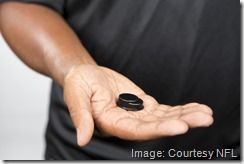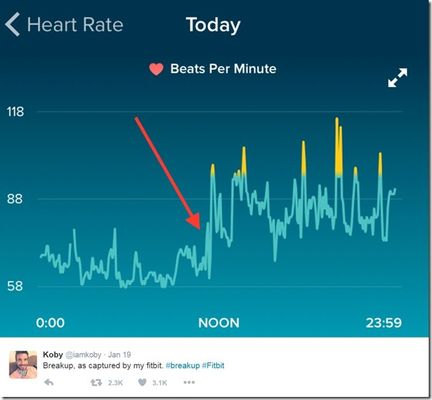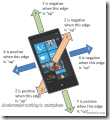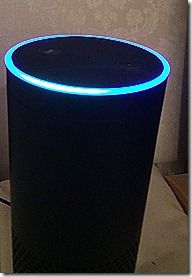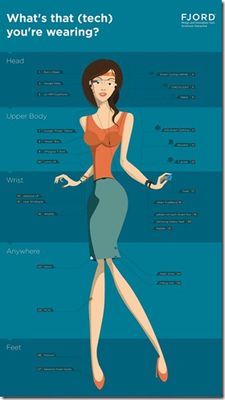sensors
26 TopicsThe Internet of Sports
Did you see what the NFL is doing this year with sensors? Earlier this month they announced a partnership with Zebra Technologies, a company that provides RFID chips for applications from 'automotive assembly lines to dairy cows' milk production.' This season there will be sensors in the player's shoulder pads which will track all their on field movements. This includes player acceleration rates, top speed, length of runs, and even the distance between a ball carrier and a defender. Next year they'll add sensors for breathing, temperature and heart rate. More stats than ever and could change the game for-ever. Imagine coaches being able to examine that data and instantly call a play based on it. Play by play. To me it somewhat takes away that 'feel' for the game flow but also having data to confirm or deny that feeling might make for exciting games. Maybe lots of 0-0 overtimes or a 70-0 blowout. Data vs. data. Oh how do I miss my old buzzing electric football game. The yardsticks will have chips along with the refs and all that data is picked up by 20 RFID receivers placed throughout the stadium. Those, in turn, are wired to a hub and server which processes the data. 25 times a second, data will be transmitted to the receivers and the quarter sized sensors use a typical watch battery. The data goes to the NFL 'cloud' and available in seconds. The only thing without a sensor is the ball. But that's probably coming soon since we already have the 94Fifty sensor basketball. And we've had the NASCAR RACEf/x for years and this year they are going to track every turn of the wrench with RFID tracking in the pits and sensors on the crew. Riddell has impact sensors in their helmets to analyze, transmit and alert if an impact exceeds a predetermined threshold. They can measure the force of a NBA dunk; they can recognize the pitcher’s grip and figure out the pitch; then the bat sensor that can measure impact to the ball, the barrel angle of their swings, and how fast their hands are moving; and they are tracking soccer player movement in Germany. Heck, many ordinary people wear sensor infused bracelets to track their activity. We've come a long way since John Madden sketched over a telestrator years ago and with 300 plus lb. players running around with sensors, this is truly Big Data. It also confirms my notion that the IoT should really be the Internet of Nouns - the players, the stadiums and the yardsticks. ps Related: Player-tracking system will let NFL fans go deeper than ever Fantasy footballers and coaches rejoice—NFL players to wear RFID tags More sensors are coming to professional sports, but research outpaces business models Why This Nascar Team Is Putting RFID Sensors On Every Person In The Pit Impact Sensors: Riddell InSite Impact Response System Fastpitch Softball League Adds Swing Sensors to its Gear Technorati Tags: rfid,sensors,IoT,things,nfl,cloud,big data,silva,f5 Connect with Peter: Connect with F5:527Views0likes1CommentHello Infiltrators - Our Doors are Wide Open
In the 1946 classic ‘Hair Raising Hare,’ Bugs Bunny asks, ‘Have you ever have the feeling you were being watched? Like the eyes of strange things are upon you?’ Like Bugs often did, he breaks the fourth wall and involves the audience directly, invoking a feeling that someone is looking over your shoulder. Today, it is likely the case that you are being watched by the strange (internet of) things that are starting to infiltrate our homes, cars, bodies and the whole of society. While there is a mad rush by people purchasing these things and a similar rush for companies to develop applications and services around those, many are not pausing to either understand the risks or build security into the products. From home security systems to surveillance cameras to baby monitors to televisions to thermostats, examples pour in daily about flaws and vulnerabilities that leave you, your family and your home exposed. The way things are going, even if you’ve closed and locked your front door physically, that door is wide open to the digital world. Here are just a few recent examples. Might as well start with our dwellings. Security researchers at Rapid7 found flaws in in Comcast’s Xfinity Home Security system that would cause it to falsely report that the home’s windows and doors are closed and secured even if they’ve been opened. It also failed to detect an intruder’s motion inside the house. Attacking the system’s communications protocol, they used radio jamming equipment to block the signals that pass from the door, window, or motion sensor to the home’s baseband hub. The system didn’t notice the communication was breached and essentially, failed open without any alert to the owner. When the jammers were turned off, it took minutes to hours for the sensors to reconnect and still didn’t give any indication that a catastrophe could have occurred. Next, to some of the things inside the insecure house. Experts are predicting that as more connected, smart-TVs enter the home, this will be an avenue for the bad guys to breach your home network. Almost half of U.S. households already have a smart-TV and close to 70% of the sets sold this year will have connectivity capabilities. A threat researcher with Symantec was able to infect his new Andriod-based smart-tele with some ransomware. Within a few seconds, the TV was locked and unusable with the fear inducing pay-up-pop-up ransom note. Also giving outsiders a view of the inside, Princeton researchers found that certain IoT thermostats were leaking customer zip codes over the internet in clear text. Fortunately, when the manufacturer was notified they quickly issued a patch. There are many horror stories about strangers watching and talking to children via insecure baby monitors. Add to that, toys that record your kid's conversations puts the whole family at risk. And out on the road, we’ve seen how researchers were able to control a Jeep and last week, researchers were able to remotely control any of the Nissan Leaf’s functions by using the mobile app’s insecure APIs. The unsecured APIs allowed anyone who knows the VIN of a car to access non-critical features like climate control and battery charge management from anywhere on the Internet. Also, someone exploiting the unauthenticated APIs can see the car's estimated driving range. They too, pulled access to the app until they can properly secure the infrastructure and application that supports the mobile app. Lastly, if you think this is contained within a consumer based household, think again. A recent Ponemon/Lookout survey revealed that an average of 1,700 malware laced mobile devices per company, connect to an enterprise network. Wait ‘til all the insecure wearables start connecting. Employees are often referred to as the weakest link. Today it is mostly their insecure mobile devices but multiply that by a wardrobe, now the risk is enhanced. ps Related: IoT Security: Do not ignore the basics IoT Effect on Applications Internet of Things OWASP Top 10 The DNS of Things Image courtesy: https://en.wikipedia.org/wiki/File:Gossamer_restored.jpg318Views0likes0CommentsWearing Emotions on Your Sleeve...Literally
Imagine if your emotions and feelings could be measured, tracked and included in a data graph. I'm sure you've heard the saying 'wearing your heart on your sleeve' to indicate that someone expresses their emotions freely or exposes their true emotions without caution. This can be good in that you become open and vulnerable when showing your true feelings but can jade areas like composure in situations where you might be frustrated or irritated. I tend to be fairly open with my emotions. There are a few stories about the origin of the saying going back to the Middle Ages. Emperor Claudius II felt unattached men make better warriors so he outlawed marriage. To alleviate some of the grievances, every year during the Roman festival honoring Juno, he'd allow temporary coupling where men drew names to determine who would be their lady friend for the year. The man would wear her name on his sleeve for the festival. Around the same time, when knights performed jousting matches, they'd dedicate their match to a lovely lady of the court. By wearing her hanky around his arm, he was signaling that he was defending her honor. And in Shakespeare's Othello, Iago confesses, For when my outward action doth demonstrate The native act and figure of my heart In complement extern, ’tis not long after But I will wear my heart upon my sleeve For daws to peck at. I am not what I am. – Othello, Act 1, Scene 1, 61–65 Whatever the origin, humans are emotional creatures. We typically make choices based on emotion, even though we'd like to think it was a rational decision. We may try to hide our emotions as to not upset or reveal something to another person. Often called a Poker Face. But imagine if your emotions and feelings could be measured, tracked and included in a data graph. Other than a polygraph. Daydream no more. There are now wearables that track your emotions. This is not your father's old-skool mood ring but devices that read your current emotional state and attempts to sooth and lower stress levels by encouraging deep breaths and relaxation techniques to get you through the haze. Sensors that gather skin temperature, sweat gland activity and blood pulse along with movement gauge your activity level. From that, it generates a graph on your mobile phone so you can see when your stress levels peaked and the mood at the time. You can see real time or over the course of the day. Emotional analysis in your pocket...or sleeve if you got one of those runner's arm band things. I'm sure someone will create a shirt that has color changing sleeve threads depending on a person's emotional state. The Iagonaut. This is not the future but today. A Fitbit captured the moment of a broken heart during a relationship ending phone call. This man was wearing his Fitbit when the unexpected call came and his daily graph tells the whole story: Koby (@iamkoby) shared his heart wrenching moment (and graph) on Twitter and it saturated the internet. The red arrow indicates the moment that the news hit him. Instantly, his heart rate jumped from 72 to 88 beats per minute and stayed high for the rest of the day. Clearly this healthy, athletic person was under duress and if you couldn't tell by the yellow peak marks, he had trouble sleeping that night. Talk about exposing your emotions with technology. Would you share your sleeve with the world? ps Related: Fitbit captures exact moment man's heart breaks The Origins of Wearing Your Heart on Your Sleeve Forget fitness, this wearable tracks your emotions Connecting the Threads The Digital Dress Code Wearables Head to Tail Gartner Says Worldwide Wearable Devices Sales to Grow 18.4 Percent in 2016 Technorati Tags: iot,wearables,emotions,humans,stress,sensors,silva,f5 Connect with Peter: Connect with F5:1.4KViews0likes0CommentsBackseat Drivers, Your Wish Has Come True
Excuse for speeding 10 years from now: ‘Officer, it was the software.’ When I was in college, I would drive the 1040 miles from Marquette Univ. in Milwaukee to my parent’s house in Rhode Island for things like summer vacation and semester break. It seemed to take forever, especially through Pennsylvania where the state speed limit at the time was 55mph. I always tried to complete it straight through yet would inevitably start the head drop and would fall asleep at some rest stop in Connecticut, about 3 hours from my goal. This is back when they still had toll booths on the Connecticut turnpike. As an adult, my family has driven the 2000 miles from California to Minnesota to visit family. In both instances, I wished I could simply doze off, take a little nap, stay on the road and awake a couple hundred miles closer to the destination. Yes, we alternated drivers but that also meant I wasn’t driving. For some reason, I had a much easier time falling asleep while holding the steering wheel than in shotgun position. Soon, you just might be able to notch that seat in recline or even stretch out in the back – do I hear third row - while your car continues on its merry way. Deutsche Telekom and Nokia conducted the first demonstration of car-to-car communication over a high speed cellular connection with close to 5G performance. And they did it on the recently inaugurated Digital A9 Motorway Test bed - Germany’s Autobahn. The cars connected over a regular LTE service optimized for rapidly moving vehicles. They used a cellular network since it is already in place and didn’t need to negotiate a digital handshake to connect. Nokia says that its technology cut the transmission lag time to under 20 milliseconds, versus today’s limit of 100+ milliseconds, give or take. And it is counting the relay time from one car to another, via a central cloud. This was simply a test to see how self-driving cars could communicate while travelling at high speeds. These connected cars will have a lot of data chatter but outside our earshot. There is also growing attention to automobile vulnerabilities as more of these driverless cars start to appear on our roads. Recorded Future has a great graphic showing some of the attacks and exploits against automakers, vehicles and components since 2010. Just like our applications, there is a growing list of the types of connected vehicle focused hackers. From researchers to criminals to insiders to competitors and even nation states are all trying to target these vehicles for their own purposes. And they all have their own motives as you can imagine. TechCrunch has an excellent article Connected Car Security: Separating Fear From Fact which digs into the short history of car vulnerability research along with the various players and what they are digging for. Meanwhile, Ford Motors announced that they will begin testing self-driving cars at a Michigan facility called Mcity. A fake town with stores, crosswalks, street lights and other scale structures to test the software and sensors controlling the car. They’ve also announced that whatever driver data is generated (which can be up to 25GB and hour) is the customer’s data. Ford says they will only share it with the customer’s informed consent and permission. And lastly, a Google self-driving car was lit-up by a CHiP in Mountain View for going too slow – 24mph in a 35 zone. Too bad no one was at the wheel to sign for the ticket. The officer quickly realized that he pulled over an autonomous car and asked the human passenger about the speed settings while reminding him of the CA Vehicle Code. This model tops out at 25mph for safety reasons and no ticket was issued. And in the future, remember this: ‘Officer, it was the software.’ ps Related: Cars Talk To Cars On The Autobahn Connected Car Security: Separating Fear From Fact Cop pulls over Google self-driving car, finds no driver to ticket Ford: Our cars will give you control of your driver data From Car Jacking to Car Hacking IoT: Tabs to be Read Later Technorati Tags: connected cars,iot,sensors,automobile,driverless,f5,silva This article originally appeared 11.19.15 on F5.com Connect with Peter: Connect with F5:339Views0likes0CommentsMeet the Sensors
I often write about the Internet of Things, or the soon-to-be-cliché IoT. You know, the smart-fridges, smart-cars, smart-thermostats, healthcare devices, wearables and any of those connected devices that have a sensor, gathers data and reports back to some entity. You are able to control these devices (and see the data) with mobile apps or even your own voice and gestures. They are all the rage and sitting at the top of the Gartner Hype Cycle. But it’s all the various sensors inside those devices that are doing the actual measuring, calculating, tracking and reporting. Each has its own specialty providing specific functionality. I’ve always wondered about what’s inside some of the wearables let’s take a look at a few. Have you ever wondered what spins the screen so you’re not looking at an upside down picture? That’s an Accelerometer. It measures orientation and movement. The iPhone was the first to use this back in 2007 and amazement ensued. It can tell the difference between running away from a charging buffalo in Yellowstone verses making faces with a chimp at the zoo. It can also tell if you’re sleeping simply by the fact that you haven’t moved for a while. These are typically used to track step count and how well you’ve rested. I noted that the accelerometer measures step count but what about those steps up a flight of stairs? Well, that would be the Altimeter. Altimeters measure altitude so it can sense changes in height. In conjunction with the steps the accelerometer counted, the altimeter will add its bits and give you a more accurate calorie count for those fire escape runs. Instead of asking how tall someone is, next time ask ‘What’s your alti?’ And if you’re going to step out for a run, you might want to know if it’ll be sunny or sprinkles during the trek. Often seen as a smaller dial on an outdoor clock but now on wristbands, a Barometer measures atmospheric pressure – the weight of air in the Earth’s atmosphere. It’s used in forecasting the weather and you often hear meteorologists note, ‘There’s a high ridge of atmospheric pressure keeping the rain away.’ At least that’s what they’ve been saying in California about the drought. So you thought of attempting an Iron Man competition but wondered if your device could differentiate between the swimming, biking and running. You’re in luck if your device has a Gyroscope. Using the Earth’s gravity, it can help determine orientation. The big difference between an accelerometer and a gyroscope is that a gyroscope can also measure rotation or more specifically, the rate of rotation around a particular axis. Gyroscopes take into account the Earth’s gravity and rotation while the accelerometer does not. If tracking stars for navigation and location like the early Polynesians is not your style, then the ever popular GPS is your tool. Using three satellites to ‘triangulate’ your location, the receiver measures distance to the first satellite. Based on that, you are in a certain sphere location on the planet. It then measures the distance to the second satellite to get another sphere location. Therefore, you must be somewhere on the circle where these two spheres intersect. By using a third satellite reading, the sphere that cuts through the circle of the intersection of the first two spheres narrows your location even more. Now our position is narrowed to two points in space. One of those two points is so absurd and instantly tossed, thus leaving you with an exact location. There are a bunch of other sensors like Optical Heart Rate Monitors, typically worn on the wrist and it shines a tiny light against your skin to measure the blood pumping through your arm veins. And the various Gesture Tech things that use a little camera to see your hand and body movements to translate that into action on a gaming device, or a drone following your Snake River Canyon jump or even turning up the volume on the TV. It’d be cool to move something out of the way by effortlessly swiping your hand in the air, huh? Sensors have been all around us for a while but now they are becoming close confidants. We should get to know our new Ohana. ps Related What do the sensors in wearable tech actually do? The World's First Urine-Powered Wearable Is Here Accelerometer vs. Gyroscope: What's the Difference? Wearables Head to Tail Oh, Is That The Internet You're Wearing? Connecting the Threads Our Five Senses on Sensors Sensors and IoT Technorati Tags: iot,wearables,sensors,humans,silva,f5,mobile Connect with Peter: Connect with F5:347Views0likes0CommentsYou Are the Device in 2016
… and the controller and data generator. Were you surprised with that new car in your driveway sporting a huge bow this holiday season? Yea, me neither. But we did get a new gaming console that doesn’t require you to hold a controller in your hand. You know The One. It has a camera that picks up your body movements and turns that into action on your screen. It’ll even scan your face and create a digitized, animated You right in front of your eyes. You can then choose your You to play games. Now I realize some of you have had these for several years but we’ve been stuck in 2010 at our house…at least with gaming consoles. For 2016, You are now the device, controller and data generator. The Consumer Electronics Show (CES) is this week and plenty of new gadgets are being unveiled to interact with our lives. Starting at the bottom, smart shoes might be the next big thing to hit stores this year. According to the manufacturer, you’ll be able to control the temperature of the shoe with a mobile app and it’ll count your steps more accurately than the thing you wear on your wrist or carry in your pocket. The temperature control idea is interesting since one of the ways to stay comfortable in the summer heat is to keep your feet cool. There’s also self-lacing shoes on display. A fitness company also unboxed smart footwear that tracks time and date, duration, distance and splits, without a runner having to carry other devices. As we move up the body, a smart belt called Belty is grabbing people’s attention. Like any other belt, it fits through your pant loops but the motorized insides will adjust loose when sitting and tighten up when you stand. You can also have it vibrate to remind you to stand every so often if you’re on your bottom too long. It keeps track, via a smartphone app, not only of your steps but also your expanding or diminishing waistline over time. Will it shame you come next Thanksgiving? Maybe not, but the sounds and sights of a roomful people unhinging their pants after a big meal might become an era gone by. There are also new fitness trackers, smart shirts, smartwatches, gesture controlled cars, grocery shopping fridges, and even a digital laser hair treatment that you put on your scalp for 90 seconds every night and the company claims that it’ll restore thinning hair. Home hubs will be built into smart televisions and fridge cams will allow you to see if the light really goes out when you close the door. Sensors in our society have become commonplace and while in the past they’ve been used to track weather, traffic conditions and how much we weigh, they are now attached to our bodies gathering information about us and reporting back. Forget about BYOD, we’re back to the old, ever popular BYOB – Bring Your Own Body. ps Related: Wearables Head to Tail Oh, Is That The Internet You're Wearing? The Digital Dress Code Connecting the Threads IoT Influence on Society Our Five Senses on Sensors Hacking the Internet of Things looms over CES Technorati Tags: f5,iot,things,ces,sensors,wearables,silva Connect with Peter: Connect with F5:371Views0likes0CommentsThe IoT Ready Platform
Over the last couple months, in between some video coverage for events, I've been writing a series of IoT stories. From the basic What are These "Things”? and IoT Influence on Society to the descriptive IoT Effect on Applications and the IoT Ready Infrastructure. I thought it only fair to share how F5 can play within an IoT infrastructure. Because F5 application services share a common control plane—the F5 platform—we’ve simplified the process of deploying and optimizing IoT application delivery services. With the elastic power of Software Defined Application Services (SDAS), you can rapidly provision IoT application services across the data center and into cloud computing environments, reducing the time and costs associated with deploying new applications and architectures. The beauty of SDAS is that it can provide the global services to direct the IoT devices to the most appropriate data center or hybrid cloud depending on the request, context, and application health. Customers, employees, and the IoT devices themselves receive the most secure and fastest experience possible. F5's high-performance services fabric supports traditional and emerging underlay networks. It can deployed a top traditional IP and VLAN-based networks, works with SDN overlay networks using NVGRE or VXLAN (as well as a variety of less well-known overlay protocols) and integrates with SDN network fabrics such as those from Cisco/Insieme, Arista and BigSwitch among others. Hardware, Software or Cloud The services fabric model enables consolidation of services onto a common platform that can be deployed on hardware, software or in the cloud. This reduces operational overhead by standardizing management as well as deployment processes to support continuous delivery efforts. By sharing service resources and leveraging fine-grained multi-tenancy, the cost of individual services is dramatically reduced, enabling all IoT applications - regardless of size - to take advantage of services that are beneficial to their security, reliability and performance. The F5 platform: Provides the network security to protect against inbound attacks Offloads SSL to improve the performance of the application servers Not only understands the application but also know when it is having problems Ensures not only the best end user experience but also quick and efficient data replication F5 Cloud solutions can automate and orchestrate the deployment of IoT application delivery services across both traditional and cloud infrastructures while also managing the dynamic redirection of workloads to the most suitable location. These application delivery services ensure predictable IoT experiences, replicated security policy, and workload agility. F5 BIG-IQ™ Cloud can federate management of F5 BIG-IP® solutions across both traditional and cloud infrastructures, helping organizations deploy and manage IoT delivery services in a fast, consistent, and repeatable manner, regardless of the underlying infrastructure. In addition, BIG-IQ Cloud integrates or interfaces with existing cloud orchestration engines such as VMware vCloud Director to streamline the overall process of deploying applications. Extend, Scale - and Secure F5 Cloud solutions offer a rapid Application Delivery Network provisioning solution, drastically reducing the lead times for expanding IoT delivery capabilities across data centers, be they private or public. As a result, organizations can efficiently: Extend data centers to the cloud to support IoT deployments Scale IoT applications beyond the data center when required. Secure and accelerate IoT connections to the cloud For maintenance situations, organizations no longer need to manually redirect traffic by configuring applications. Instead, IoT applications are proactively redirected to an alternate data center prior to maintenance. For continuous DDoS protection, F5 Silverline DDoS Protection is a service delivered via the F5 Silverline cloud-based platform that provides detection and mitigation to stop even the largest of volumetric DDoS attacks from reaching your IoT network. The BIG-IP platform is application and location agnostic, meaning the type of application or where the application lives really does not matter. As long as you tell the BIG-IP platform where to find the IoT application, the BIG-IP platform will deliver it. Bringing it all together, F5 Synthesis enables cloud and application providers as well as mobile network operators the architectural framework necessary to ensure the performance, reliability and security of IoT applications. Connected devices are here to stay—forcing us to move forward into this brave new world where almost everything generates data traffic. While there’s much to consider, proactively addressing these challenges and adopting new approaches for enabling an IoT-ready network will help organizations chart a clearer course toward success. An IoT-ready environment enables IT to begin taking advantage of this societal shift without a wholesale rip-and-replace of existing technology. It also provides the breathing room IT needs to ensure that the coming rush of connected devices does not cripple the infrastructure. This process ensures benefits will be realized without compromising on the operational governance required to ensure availability and security of IoT network, data, and application resources. It also means IT can manage IoT services instead than boxes. However an IoT ready infrastructure is constructed, it is a transformational journey for both IT and the business. It is not something that should be taken lightly or without a long-term strategy in place. When done properly, F5-powered IoT ready infrastructure can bring significant benefits to an organization and its people. ps Related: The Digital Dress Code Is IoT Hype For Real? What are These "Things”? IoT Influence on Society IoT Effect on Applications CloudExpo 2014: The DNS of Things Intelligent DNS Animated Whiteboard The Internet of Me, Myself & I Technorati Tags: f5,iot,things,sensors,silverline,big-ip,scale,sdas,synthesis,infrastructure Connect with Peter: Connect with F5:658Views0likes2CommentsArguing with Things
As more things get connected, we may find ourselves disagreeing with them. We all argue, especially if you’re passionate about something. Sometimes it’s with our spouse, sometimes with friends or co-workers and sometimes we scold objects that aren’t doing what we want them to do, ‘Ah, come on pen…don’t run out of ink now!!’ As more of these things get connected and are interacting with us, will you find yourself arguing with inanimate objects even more? The other day I was talking to my wife about Alexa (the Amazon Echo) and suddenly from the other room we hear, ‘I will add that item to the shopping cart.’ We looked at each other and simultaneously said, ‘What was that?’ with the added ‘jinx’ that quickly follows. We walked over to the device and started interrogating it as to what it just added to the cart. ‘I don’t understand the question…I can’t seem to find what you are looking for…I can’t understand what you said,’ were the various responses. These answers would drive a detective to charge it with obstructing justice. This is not a complaint against Echo mind you, we like it. It just couldn’t understand our questions until we asked the right way. It also seems to have feelings. My daughter told it that it was stupid (for not understanding us) and Echo replied with, ‘That’s not very nice.’ M3S looked at me, looked at Alexa and then apologized to the cylinder. Not sure if she forgave us, but we’re a little more courteous around her now. Over at The Guardian, Rory Carroll experienced the same thing and he writes about how these home robots hear everything and the types of data captured by many of these home services. There are no more boundaries between home and the outside world. When I’m in the car and pass the intended route, the GPS keeps telling me to make my first legal U-turn, even though I know where I’m going. On a few occasions I’ve quipped, ‘Stop bossing me around!’ It ignores me and keeps reiterating that I’m going the wrong way. Tossing it in the back seat doesn’t help. With the holiday season upon us and wish lists getting fulfilled, you may find that in 2016, your quarrels will be with gaming consoles, thermostats, fitness trackers, security cameras, refrigerators and other gadgets instead of humans. I guess that’s better than making a scene at the dinner table.* ps * Except in cases where smart utensils have been deployed. Related Goodbye privacy, hello 'Alexa': Amazon Echo, the home robot who hears it all Connecting the Threads Wearables Head to Tail Our Five Senses on Sensors Internet of Food The IoT Ready Platform Technorati Tags: iot,things,sensors,wearables,holiday,argue,silva,digital assistant,privacy Connect with Peter: Connect with F5:294Views0likes0CommentsWearables Head to Tail
Have you sent Santa your list of all the wearables you'll want under the tree this year? Maybe you've asked for a fitness tracker, a health monitor or that fancy new smart watch. But don't stop there! As we continue to integrate technology with our desire for self-improvement and lifestyle control, a slew of wearables - from arm bands to socks to bras to a dog tail-wagging monitor - will be clipped, adhered, buttoned, inserted, ingested or worn to gather our vitals, movement and lives as we toast 2015 goodbye. Naughty or nice, if you're still unsure which wearables you want watching you, Fjord (part of Accenture Interactive) has a nifty infographic showing the multitude of gadgets for various body parts. From the head to upper body to wrists to feet to anywhere, our body has become both the controller and interface according to Fjord. Their research indicates that about 70% of wearables are intended to monitor our body in some way, with the remaining 23 percent designed for communication. 59% of these health-oriented devices monitor your health and 48 percent track fitness. Around 7% can help a person sleep better. Fjord predicts that wearable technology will become a growing trend for health care providers and digital applications for health care organizations have become a growing area of focus for Fjord. On your head you can wear a smart cycling helmet which takes your pulse and reports it to a smartphone app or a brain activity measurement tool to help understand and improve focus. On your upper body you can have a sensor and app tell you when you are slumping to improve posture or a t-shirt designed to capture biometrics or even the Microsoft Smart Bra designed to measure perspiration and heart rate in order to detect emotional triggers. Of course for the wrist we got the smart watches and fitness trackers but there is also devices that can tell you about sun exposure, how much food you've eaten and calories burned during the feeding frenzy. For your feet and pretty much anywhere on or in your body, there are smart socks that track your running technique with sensors around the ankle, sensors in the sole of shoes to measure motion parameters, gadget sensors that fit in your pocket for movement measurements and even second skin type materials that stick anywhere on the body and provides personalized health data on a variety of measurements. And if that's not enough, there are ingestible sensors that can monitor how much medicine is absorbed by the body and the PillCam that gives you a colonoscopy by having a light and two color video cameras within the pill. Not to be left out, your pet is also pawing up their list and DogStar Life is working on building TailTalk, a tail-mounted sensor intended to track your dog's emotions based on tail movements. Built into this tail clip-on is an accelerometer and gyroscope so it knows the difference between happy tail-wagging when you walk in the door verses when the tail is tucked or standing at attention. The sensor then sends the information to an app that translates the movement data into emotions, telling you if your dog is stressed, happy or crazy thrilled. And soon, I'm sure, there will be one that measures your significant other's reaction to the lame gift you got them. Like the evil eye death stare data isn't enough. ps Related INFOGRAPHIC: All The Wearables You Could Be Wearing Right Now Tail-monitoring gadget tries to sense your dog's emotions Are Ingestible Tracking Devices The Wearables Of The Future? Oh, Is That The Internet You're Wearing? The Digital Dress Code I Think, Therefore I am Connected IoT Influence on Society Technorati Tags: iot,wearables,sensors,body,clothes,fitness,healthcare,silva Connect with Peter: Connect with F5:364Views0likes0CommentsIoT: Tabs to be Read Later
I've been traveling a bit over the last month and my tabs-to-read-later pile is growing. We'll be at AWS re:Invent next week so I thought I'd unload some of the IoT stories that caught my eye recently, that I'm finally getting to read. Apologies if this is old news to you. One I've been holding on to almost the longest is an interesting INC article Our Future Will be Analog, Not Digital. Geoffrey James talks about the Internet of Things and how people think the convenience of connectivity is more important than the risks involved. He talks about how snail mail, cash and unplugging are tending up along with how analog objects are becoming status symbols. This is a good one if you think all this connectivity will become so hackable and fragile that no one will want to use it. Next from The Economist, saying on the IoT theme, is Their own Devices. From Barbie's to cars to televisions, compromised computers are all over the place and few companies have the incentive to take security seriously within their widgets. There needs to be a change in corporate culture especially within non-computer companies. From the early days of the boiler explosions and crashes on railways to the safety of cars in the 70's to the hacks of medical devices today, we all need to recognize that connected devices need protection. And so do we. To that, from Mashable, is how Major automakers are forming an alliance to tackle cybersecurity.With the growing concerns and actual demonstrations of cars getting breached, the Alliance of Automobile Manufacturers and the Association of Global Automakers are forming an Information Sharing and Analysis Center, according to Automotive News. Chris Perkins says, the creation of the Information Sharing and Analysis Center (ISAC) represents an important proactive step from the industry to address these hacks before they happen. The last couple years during the NFL season, I've written some stories about technology in sports including Are You Ready For Some...Technology!! and more recently with Will Deflate-Gate Lead to Micro-Chipped Footballs? On Ars Technica, David Kravets goes deeper into the sensor technology being used by the NFL this year with How the NFL—not the NSA—is impacting data gathering well beyond the gridiron. He talks about how RFID is being used to track all the player's movements and how they will use the 2 to 3 gigs of data generated each game. Also how teams can use the data for training and coaching along with how console gaming might use it and how it could affect fantasy bets. Very interesting article on how all this connectivity plays into the games we watch, play and enjoy. OK, that's it for now and thanks for the chance to clean up some of my browser tabs. Now I got room for the next bunch. ps Technorati Tags: iot,sensors,things,digital,nfl,cars,security,silva Connect with Peter: Connect with F5:323Views0likes0Comments
